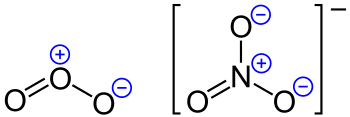
Back Formalladung German Carga formal Spanish بار قراردادی Persian Charge formelle French מטען פורמלי HE औपचारिक आवेश Hindi Muatan formal ID Carica formale Italian 형식 전하 Korean Formele lading Dutch

In chemistry, a formal charge (F.C. or q*), in the covalent view of chemical bonding, is the hypothetical charge assigned to an atom in a molecule, assuming that electrons in all chemical bonds are shared equally between atoms, regardless of relative electronegativity.[1][2] In simple terms, formal charge is the difference between the number of valence electrons of an atom in a neutral free state and the number assigned to that atom in a Lewis structure. When determining the best Lewis structure (or predominant resonance structure) for a molecule, the structure is chosen such that the formal charge on each of the atoms is as close to zero as possible.[2]
The formal charge of any atom in a molecule can be calculated by the following equation:
where V is the number of valence electrons of the neutral atom in isolation (in its ground state); L is the number of non-bonding valence electrons assigned to this atom in the Lewis structure of the molecule; and B is the total number of electrons shared in bonds with other atoms in the molecule.[2] It can also be found visually as shown below.
Formal charge and oxidation state both assign a number to each individual atom within a compound, they are compared and contrasted in a section below.
- ^ Hardinger, Steve. "Formal Charges" (PDF). University of California, Los Angeles. Archived from the original (PDF) on 12 March 2016. Retrieved 11 March 2016.
- ^ a b c "Formal Charge". Royal Society of Chemistry. Retrieved 10 December 2021.
© MMXXIII Rich X Search. We shall prevail. All rights reserved. Rich X Search
